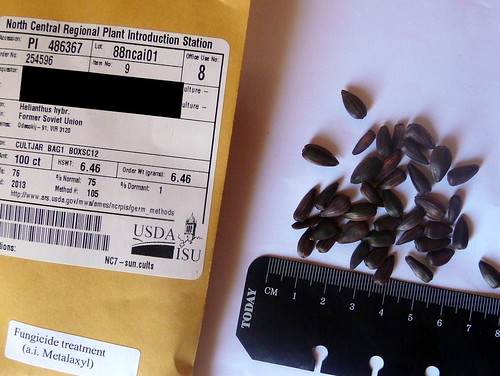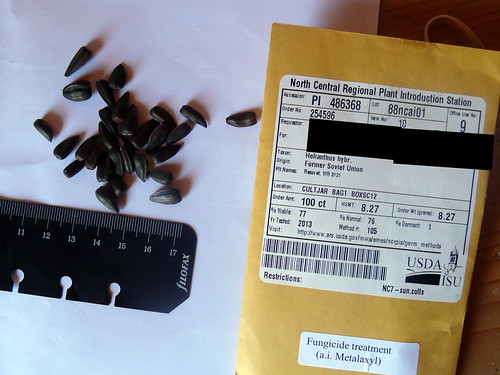|
|
Post by nicolas on Mar 1, 2014 11:21:06 GMT -5
Maybe you can try to graft your hybrid to a H. annuus rootstock to induce seed production ? It seems to work with potato on tomato, so why not ? It will not be surprising because the study i linked seems to confirm that some hybrids performed better than JA for tuber production.
|
|
|
|
Post by wildseedvt on Mar 3, 2014 8:58:31 GMT -5
Wow what a wealth of information! Thanks for the link Nicolas, glad to be here.
|
|
|
|
Post by nicolas on Mar 3, 2014 9:11:07 GMT -5
From the last study i've posted link, p. 92:  I dont know if the H. annuus population was big seeded (cultivars for oil production are bred for oil content rather than seed size), but it seems pretty interesting even on the F2 generation (=IM1F1 that is a cross between F1s of the H. annuus x H. tuberosus original crosses) (welcome here wildseedvt !) |
|
|
|
Post by nicolas on Mar 3, 2014 9:20:04 GMT -5
|
|
|
|
Post by nicolas on Mar 4, 2014 6:39:33 GMT -5
|
|
|
|
Post by starry on Mar 4, 2014 9:16:18 GMT -5
you are a research machine nicolas! great stuff
|
|
|
|
Post by starry on Mar 11, 2014 9:50:40 GMT -5
I have Titan and Russian Mammoth sunflower so far to use for crossing. I'm thinking maybe just to use these two and plant 10 of each and stagger the plantings to increase chances of overlap in flowering between the sunroots and the sunflowers. Any thoughts/opinions?
|
|
|
|
Post by nicolas on Mar 12, 2014 2:20:06 GMT -5
Seems a good plan. You can search for more big seeded sunflowers from ARS GRIN : www.ars-grin.gov/cgi-bin/npgs/html/obvalue.pl?79064I think i'll going to split this project in two branches, one for big seeds for snack and the other for oil content. I've got a little garden but once the project is in F1s its much easier to keep mix oil/big seeds cultivars pure thanks to perenniality. |
|
|
|
Post by nicolas on May 5, 2014 11:54:11 GMT -5
|
|
|
|
Post by nicolas on May 9, 2014 11:26:09 GMT -5
So maybe good progresses here, at least one path to follow. I've ordered some helianthus hyrbids on GRIN USA and Canada and received them. There are sprouting right now. So now i'm planning to grow them and check if some are perennials. The one from Canada is just labeled Helianthus hybrid, but on there site it is supposed to mean tuberosus x annuus but they have annuus hybrids listed in it. The two from US comes from USSR and labeled tuberosus x anuus, but there names are same as H. annuus cultivars (but these name can be just those of the annuus parents), and seems quite big and with a great oil content so it may be to good to be true, or russians have excelled in their work to breed some perennial sunflowers ... (and the seeds from GRIN USA seems to not be from them as i received a paper stating that all their seeds are untreated).    i should received H. annuus bred for oil too, and a chinese accession of H. annuus with the biggest seeds of the GRIN US database  Perenniality is a good way to have several cultivars/landraces of sunflower (eg one for snack and one for oil) without much fear of cross pollination if it is easy to propagate vegetatively (some hybrids have "large" tubers in one of the studies cited earlier). |
|
|
|
Post by starry on May 9, 2014 12:32:24 GMT -5
Very cool.
Those seeds all look to be a good size so that would be a great start if in fact they are a tuberosus x annuus hybrid.
Had a bit of a setback in my project with the loss of 2 of my sunroot varieties to rot but still have 3 to use for crossing. With any luck a few pieces of the rotted ones still remain somewhere and will sprout ... I'll just have to wait and see.
Have potted up the sunroots ... just need to start my staggered planting of the sunflower seeds.
Collected a few sunroot seeds last year from the 'clearwater' sunroot and they have germinated so I can put those into the mix as well.
|
|
|
|
Post by nicolas on May 10, 2014 0:11:12 GMT -5
Sorry for the loss of your JA
Another explanation for the seeds i've received is an intended interspecific cross to add some disease resistance from JA, and then selection on size or oil criteria. So perenniality could be a side effect of such crosses.
|
|
|
|
Post by nicolas on Jun 4, 2014 6:46:03 GMT -5
|
|
|
|
Post by darrenabbey on Nov 20, 2014 2:30:40 GMT -5
After staring at it for a bit I am assuming it is just showing that if you breed the various species together in the combinations shown you can get a population of hybrids that all have the same number of chromosomes? It goes a bit further than that. The wild diploid annual and diploid perennial species can't cross due to some incompatability. They can both can cross with the hexaploid perennial species to produce tetraploid progeny. The tetraploid progeny from any of the crosses can then cross with any other tetraploid. The result is a genetically diverse tetraploid population with genetics from both previously incompatible diploid species. Back-crossing any of the tetraploids to H. annuus will produce a largely sterile triploid plant. Back-crossing the tetraploids to H. tuberosus would produce a largely sterile pentaploid plant. The tetraploid population is essentially now a separate species from the parent diploids and hexaploids and there is no reason the tetraploid population would ever need to end. I'm surprised how often people seem to think that back-crossing is the next step after the first hybrid has been generated. I've got some blog posts about this topic: www.the-biologist-is-in.blogspot.com/search/label/sunflowers |
|
|
|
Post by nicolas on Nov 20, 2014 3:46:48 GMT -5
Glad to see you here Darren.
Great project you have, so your goal is to have a JA with more giant growth ? You'll select for tuber size, head or seed size too ? I found JA flowers so pretty than adding a bit of color from ornamental sunflowers would be great for sure.
Any tips about the cross pollination to report ?
For the backcroosing thing, i think it is because of the way breeding works today, if i've understand correctly it is based on vertical bredding to add a particular gene (often from wild stock) and thus get rid of as much of the other specy genetic as possible.
|
|